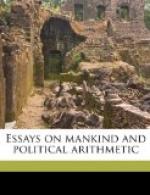INTRODUCTION.
William Petty, born on the 26th of May, 1623, was the son of a clothier at Romsey in Hampshire. After education at the Romsey Grammar School, he continued his studies at Caen in Normandy. There he supported himself by a little trade while learning French, and advancing his knowledge of Greek, Latin, Mathematics, and much else that belonged to his idea of a liberal education. His idea was large. He came back to England, and had for a short time a place in the Navy; but at the age of twenty he went abroad again, and was away three years, studying actively at Utrecht, Leyden, and Amsterdam, and also in Paris. In Paris he assisted Thomas Hobbes in drawing diagrams for his treatise on optics. At the age of twenty-four Petty took out a patent for the invention of a copying machine. It was described in a folio pamphlet “On Double Writing.” That was in 1647, in Civil War time, and although Petty followed Hobbes in his studies, he did not share the philosopher’s political opinions, but held with the Parliament. In 1648 he added to his former pamphlet a “Declaration concerning the newly invented Art of Double Writing.”
Samuel Hartlib, the large-hearted Pole, who in those days spent his worldly means in England for the advancement of agriculture and of education, and other aids to the well-being of a nation, had caused Milton to write his letter on education, as has been shown in the Introduction to the hundred and twenty-first volume of this Library, which contains that Letter together with Milton’s Areopagitica. Young Petty’s first published writing was a Letter to Hartlib on Education, entitled “The Advice of W. P. to Mr. Samuel Hartlib for the Advancement of some Particular Parts of Learning.” This appeared in 1648, when Petty’s age was twenty-five, and its aim was to suggest a wider view of the whole field of education than had been possible in the Middle Ages, of which schools and colleges were then preserving the traditions, as they do still here and there to some extent. This pamphlet has been reprinted in the sixth volume of the “Harleian Miscellany.” William Petty wished the training of the young to be in several respects more practical.
His own activity of mind caused him to settle at Oxford, where he taught anatomy and chemistry, which he had been studying abroad. He had read with Hobbes the writings of Vesalius, the great founder of modern practical anatomy. In 1649 William Petty graduated at Oxford as Doctor of Medicine, obtained a fellowship at Brasenose, and practised. In 1650 he surprised the public by restoring the action of the lungs in a woman who had been hanged for infanticide, and so restoring her to life.
Dr. Petty now took his place at Oxford among the energetic men of science who had been inspired by the teaching of Francis Bacon to seek knowledge by direct experiment, and to value knowledge above all things for its power of advancing the welfare of man. The headquarters of these workers were at Oxford, and in London at Gresham College.




